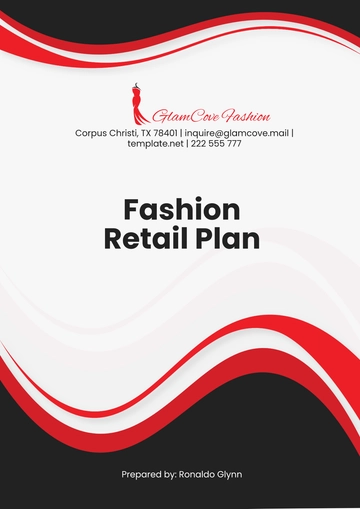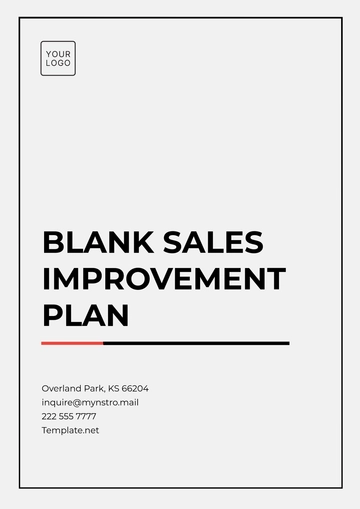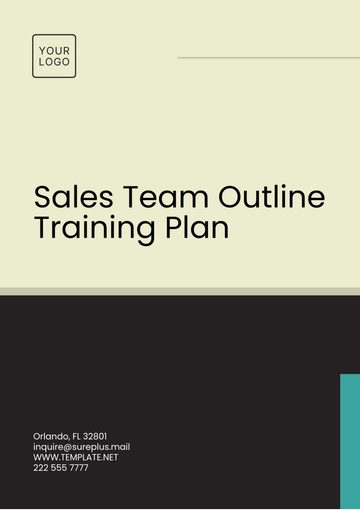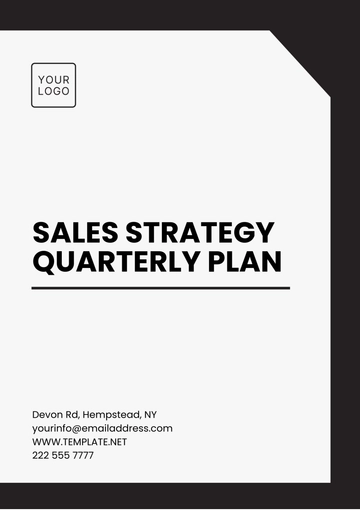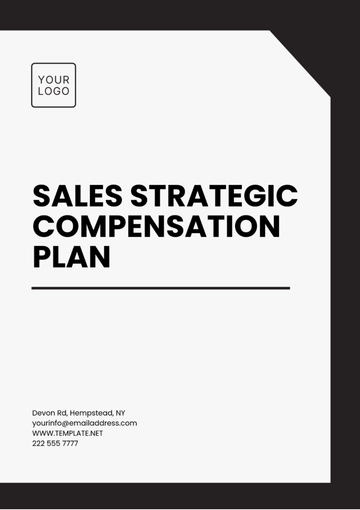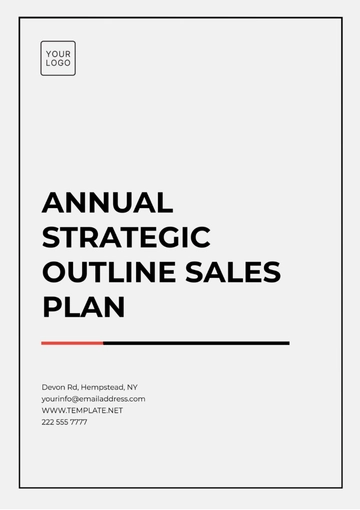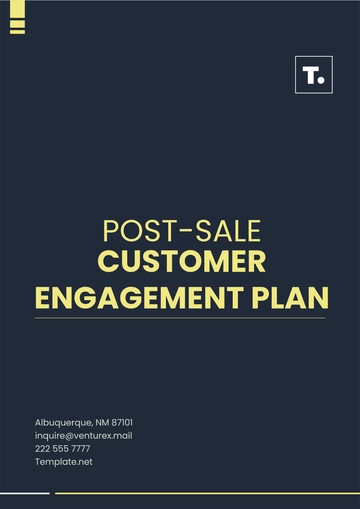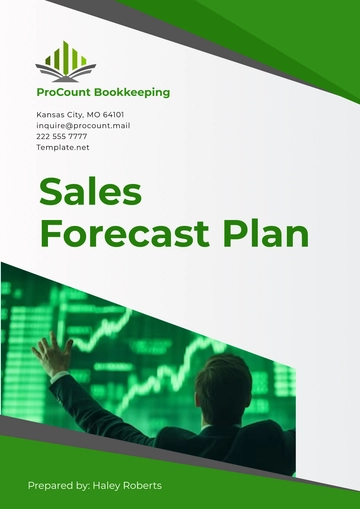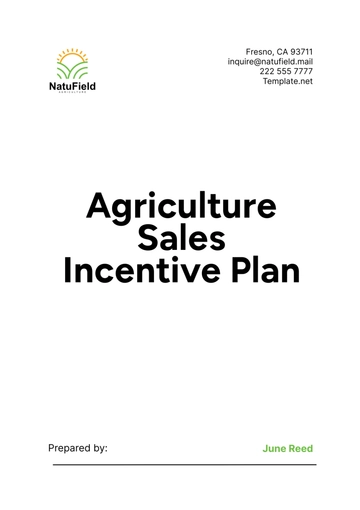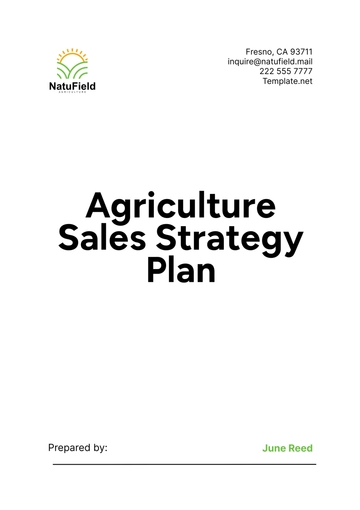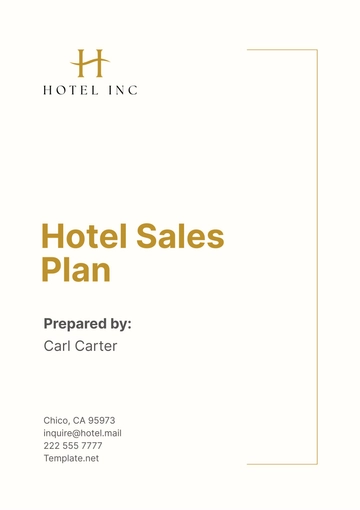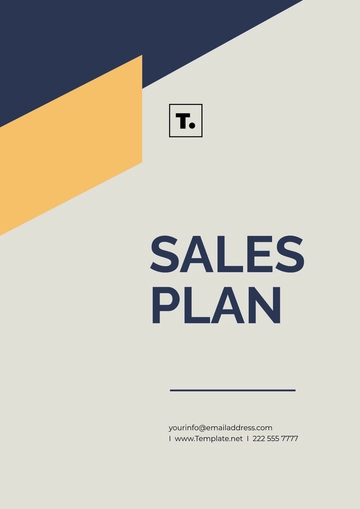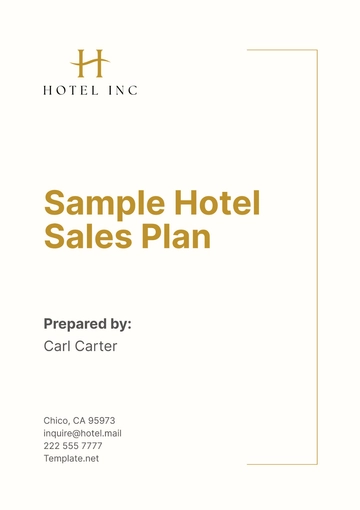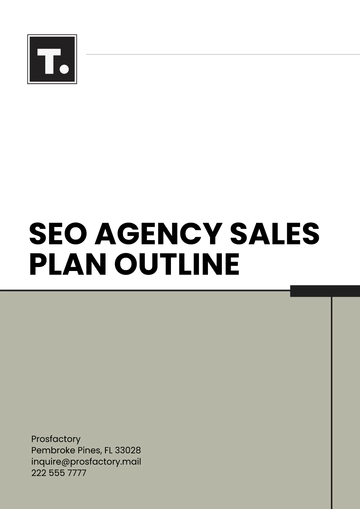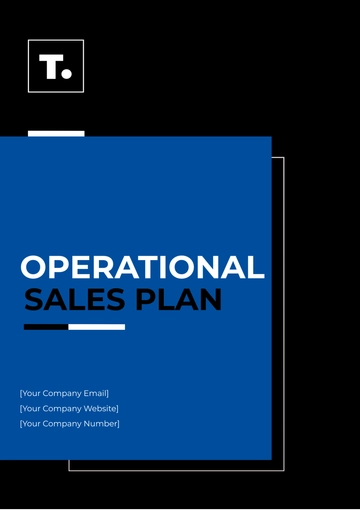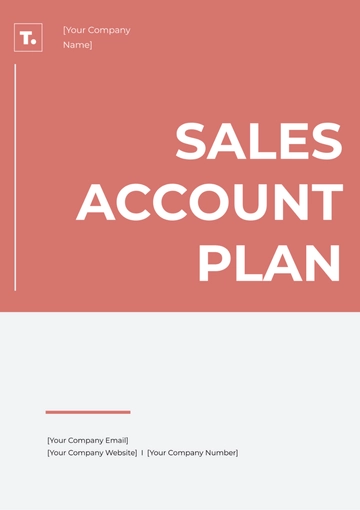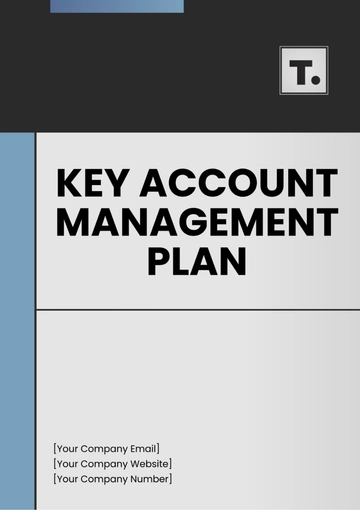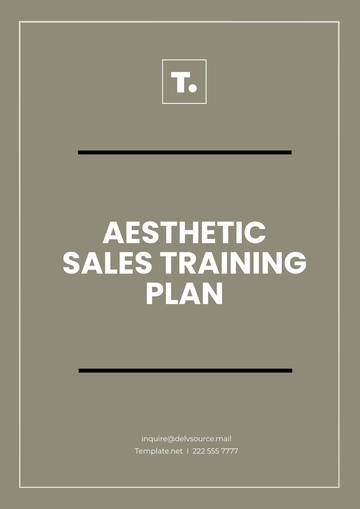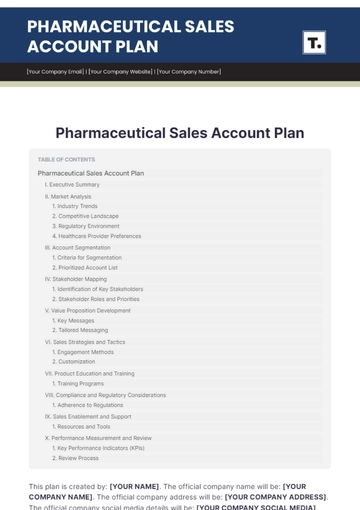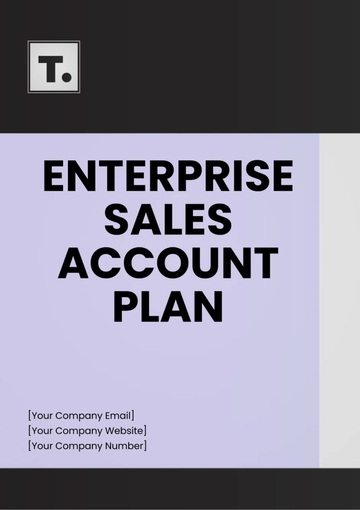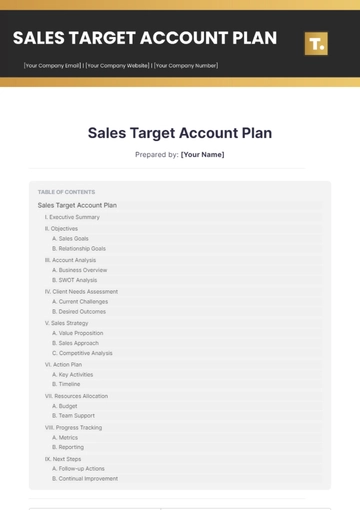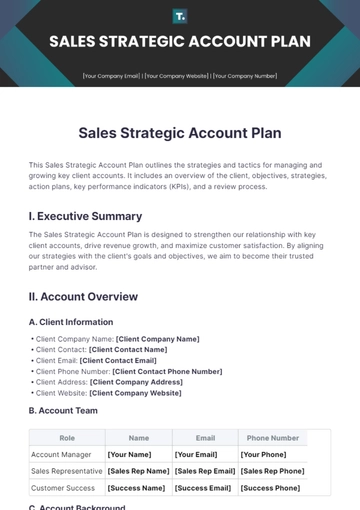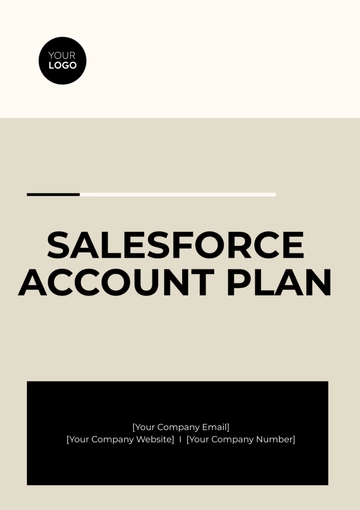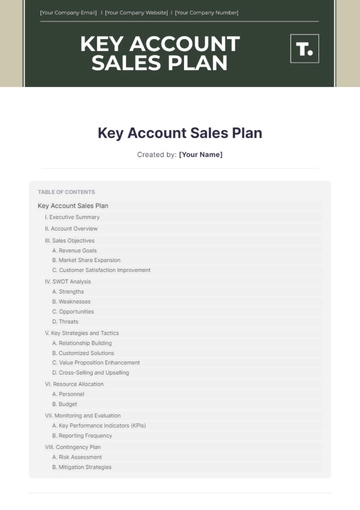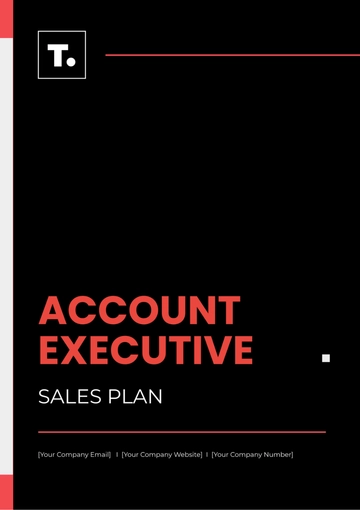Free Go-to-Market Sales Plan

I. Executive Summary
In this Go-to-Market (GTM) Sales Plan, [Your Company Name] outlines a detailed strategy to successfully introduce new products to the market between 2050 and 2055. Our approach focuses on identifying key market opportunities, segmenting target customers, creating sales strategies, and establishing metrics for tracking performance. As we navigate the evolving landscape of technological advancements and consumer expectations, it is crucial for [Your Company Name] to maintain agility in our strategies and adapt to emerging trends.
By leveraging comprehensive market research, competitive analysis, and innovative sales techniques, [Your Company Name] aims to secure a dominant market position in its industry. The GTM sales plan includes specific revenue goals, sales team structures, marketing collaborations, and product-specific sales strategies. Furthermore, this document will outline anticipated financial growth, with projected annual revenue expected to increase by [15%] each year until 2055. This growth will be driven by expanding our product offerings, optimizing our sales processes, and enhancing customer relationships.
II. Market Opportunity Assessment
A. Market Analysis
1. Industry Overview
The global industry landscape in 2050 is increasingly competitive, driven by the fast-paced advancement of artificial intelligence (AI), quantum computing, and sustainability practices. These technologies are reshaping how businesses operate, creating a demand for innovative solutions that enhance efficiency and reduce environmental impact. [Your Company Name] will target niche sectors with exponential growth, such as renewable energy technology, AI-driven healthcare solutions, and smart infrastructure. According to market research, these sectors are projected to grow at an average rate of [12%] per annum by 2055.
In addition, there is a growing trend towards sustainability and corporate social responsibility (CSR) as consumers become more aware of environmental issues. Companies that prioritize eco-friendly practices are not only meeting regulatory requirements but are also appealing to a socially-conscious customer base. This evolving landscape presents an opportunity for [Your Company Name] to position itself as a leader in sustainable innovations.
2. Market Size and Growth Potential
Based on our internal analysis, the total addressable market (TAM) for our key sectors is estimated at $[500 billion] in 2050, with a compound annual growth rate (CAGR) of [10%] over the next five years. The serviceable available market (SAM) for [Your Company Name] in specific regions such as North America, Europe, and Asia-Pacific is projected at $[300 billion] by 2055. These projections indicate that a significant opportunity exists for capturing market share by delivering innovative and effective solutions that cater to current and future demands.
3. Competitive Landscape
The competition in the targeted industries includes both well-established enterprises and disruptive startups. Some competitors are heavily focused on AI-driven automation, while others emphasize sustainable product innovation. [Your Company Name] will differentiate itself through high-quality products that integrate both AI and sustainable practices, offering superior performance at competitive prices. In addition to product differentiation, we will focus on enhancing customer experience and building long-lasting relationships.
We will continuously monitor competitor activities to stay informed of their strategies, market positioning, and new product launches. This proactive approach will enable [Your Company Name] to pivot quickly in response to competitive threats or opportunities, ensuring we remain at the forefront of the industry.
B. Target Market Segmentation
1. Customer Segments
To maximize our market penetration, we will segment our target audience into three distinct categories:
Customer Segment | Description | Projected Revenue Contribution by 2055 |
|---|---|---|
Enterprise Clients | Large corporations in need of scalable AI and renewable energy solutions. | [60%] of total sales |
Small to Medium-Sized Enterprises (SMEs) | Mid-sized businesses that benefit from affordable, modular solutions. | [25%] of total revenue |
Government and Public Sector | Public entities requiring sustainable infrastructure solutions. | [15%] of our target market |
Enterprise clients will be prioritized due to their substantial purchasing power and need for customized solutions. They often seek long-term partnerships that provide strategic advantages, making them an essential focus for our sales efforts.
2. Regional Market Focus
Our initial sales efforts will concentrate on regions that show the highest growth potential:
Region | Projected Revenue by 2055 |
|---|---|
North America | $[100 billion] |
Europe | $[80 billion] |
Asia-Pacific | $[120 billion] |
By concentrating our resources on these regions, [Your Company Name] aims to establish a strong foothold and gradually expand to emerging markets with substantial growth opportunities. North America, being a technology hub, provides significant opportunities for AI solutions, while Asia-Pacific’s rapid industrialization presents a unique demand for sustainable technologies.
3. Customer Needs and Pain Points
The following customer needs have been identified:
Cost Efficiency: Many enterprises are seeking ways to reduce operational costs through automation and energy-efficient solutions. As a response, [Your Company Name] will offer products that not only enhance efficiency but also deliver long-term savings.
Regulatory Compliance: Governments and businesses must adhere to strict environmental and data privacy regulations, creating a demand for compliant solutions. Our products will be designed to meet or exceed these standards, providing peace of mind to customers.
Technological Adaptation: Businesses need to stay ahead of technological advancements, particularly in AI and renewable energy sectors. [Your Company Name] will invest in R&D to ensure our offerings are always at the cutting edge of technology.
By addressing these needs, [Your Company Name] aims to build a reputation as a trusted partner in innovation and sustainability.
III. Sales Strategy
A. Value Proposition
1. Product Differentiation
The key differentiators of [Your Company Name]'s products are their advanced AI capabilities, integrated with cutting-edge sustainable materials. These products not only outperform competitors in functionality but also reduce long-term operational costs through energy-efficient designs. By offering customizable solutions, [Your Company Name] provides flexibility to meet the unique needs of each customer segment. Our commitment to sustainability ensures that our customers can contribute positively to the environment while benefiting from our technology.
Furthermore, our product line will include regular updates and enhancements based on customer feedback and technological advancements. This iterative approach ensures that we remain responsive to customer needs and market trends, fostering loyalty and repeat business.
2. Pricing Strategy
Our pricing strategy will focus on value-based pricing, where we align product prices with the value delivered to the customer. By targeting enterprise-level customers, [Your Company Name] will offer subscription models for software and AI services, with initial entry costs ranging from $[50,000] to $[500,000] depending on the scale of the project.
Smaller customers, such as SMEs, will be offered tiered pricing with monthly subscription options starting at $[1,000] per month. This pricing model not only makes our products accessible to a wider audience but also allows customers to scale their investment as their needs grow. We will also explore seasonal promotions and bundled offers to incentivize early adoption.
B. Sales Channels
1. Direct Sales
A robust direct sales team will be essential to reaching large enterprise clients and government contracts. This team will focus on building long-term relationships, managing complex sales cycles, and driving high-value deals.
Sales Team Structure: The sales team will consist of [200] enterprise sales executives by 2055, each managing accounts valued at $[10 million] or more. This structure will ensure that each executive is focused on high-potential clients, allowing for more personalized engagement.
Sales Tools: Customer relationship management (CRM) systems powered by AI analytics will enable the sales team to forecast accurately and tailor outreach efforts. These tools will also provide insights into customer behavior, helping to refine sales pitches and strategies.
2. Channel Partnerships
To expand our reach in smaller markets and specialized sectors, [Your Company Name] will form channel partnerships with value-added resellers (VARs) and systems integrators. These partners will help distribute our products globally and target sectors where we have limited direct sales capacity.
Projected channel sales are expected to contribute [30%] of total revenue by 2055. These partnerships will allow us to tap into existing networks and customer bases, accelerating our market penetration while reducing the costs associated with establishing a direct presence.
3. E-Commerce and Digital Sales
The integration of AI-driven e-commerce platforms will allow [Your Company Name] to reach SMEs directly. These platforms will feature customized product recommendations, easy subscription models, and 24/7 customer support. Online sales are forecasted to generate $[50 million] annually by 2055, as we capitalize on the growing trend of online purchasing among businesses.
The e-commerce platform will also include educational resources, such as webinars and product comparison tools, to help customers make informed purchasing decisions. We will implement data analytics to track customer interactions and optimize the online shopping experience continually.
C. Sales Tactics
1. Lead Generation and Qualification
[Your Company Name] will adopt a multi-channel lead generation approach, leveraging the following methods:
Inbound Marketing: Content marketing, webinars, and thought leadership to attract leads. By creating valuable and relevant content, we will establish [Your Company Name] as a trusted authority in our industry.
Outbound Sales: Targeted email campaigns and AI-driven prospecting tools to engage decision-makers in key industries. These targeted efforts will ensure that our sales team is focusing on high-potential leads that align with our business objectives.
Lead qualification will be performed using AI-powered tools that score prospects based on their interaction with our marketing materials, budget capacity, and alignment with our ideal customer profile. This approach will reduce the sales cycle length and enhance conversion rates.
2. Sales Training and Development
Ongoing training and development programs will ensure that our sales team is equipped with the necessary skills and knowledge to succeed. The training program will include:
Product Knowledge: Comprehensive training on new products, including features, benefits, and competitive advantages.
Sales Skills: Workshops on consultative selling techniques, negotiation tactics, and relationship management.
Technology Utilization: Training on using sales enablement tools, CRM systems, and AI-driven analytics to improve efficiency and effectiveness.
By investing in our sales team's professional development, we aim to foster a culture of excellence and innovation that drives results.
3. Customer Engagement and Relationship Building
Building long-lasting relationships with customers is key to our sales strategy. [Your Company Name] will implement several initiatives to enhance customer engagement, including:
Regular Check-Ins: Sales representatives will maintain regular contact with clients through quarterly business reviews and feedback sessions to ensure their needs are being met.
Customer Events: Hosting exclusive events, webinars, and training sessions to showcase new products and share industry insights, fostering a sense of community among our customers.
Loyalty Programs: Introducing rewards programs for repeat customers, offering discounts, exclusive access to new products, and personalized service to enhance loyalty and satisfaction.
This focus on relationship-building will not only drive customer retention but will also turn satisfied customers into advocates who can promote [Your Company Name] within their networks.
IV. Marketing Strategy
A. Branding and Positioning
1. Brand Identity
[Your Company Name] aims to position itself as an innovator in sustainable technology solutions. Our brand will be synonymous with reliability, efficiency, and environmental responsibility.
Brand Messaging: Key messages will emphasize our commitment to sustainability, cutting-edge technology, and customer-centric solutions. Messaging will be consistently conveyed across all channels to build a strong, recognizable brand.
Visual Identity: Our visual identity will reflect our values through eco-friendly design elements and modern aesthetics, appealing to both traditional and environmentally conscious customers.
2. Market Positioning
Our positioning statement will highlight [Your Company Name] as the go-to provider of AI-driven and sustainable solutions for enterprises and SMEs alike. We will emphasize our ability to deliver measurable results, such as cost savings and enhanced operational efficiency, setting us apart from competitors who may lack this dual focus.
B. Marketing Tactics
1. Digital Marketing
Digital marketing will be a cornerstone of our strategy, leveraging the following channels:
Search Engine Optimization (SEO): Optimizing our website and content for search engines to attract organic traffic and generate leads.
Pay-Per-Click (PPC) Advertising: Targeted advertising campaigns across platforms like Google Ads and social media to drive immediate traffic and conversions.
Social Media Engagement: Utilizing platforms such as LinkedIn, Twitter, and Instagram to connect with potential customers, share valuable content, and build a community around our brand.
By employing a data-driven approach to digital marketing, we will continuously refine our campaigns based on performance metrics to maximize ROI.
2. Content Marketing
Content marketing will play a vital role in our strategy to educate prospects and establish thought leadership. Our content strategy will include:
Blog Posts and Articles: Regularly publishing informative articles that address industry trends, challenges, and solutions.
Whitepapers and Case Studies: In-depth reports that showcase successful implementations of our products, highlighting quantifiable results and customer satisfaction.
Webinars and Podcasts: Interactive sessions with industry experts to engage our audience and provide valuable insights.
By providing valuable content, we aim to build trust and credibility with our audience, ultimately guiding them through the sales funnel.
3. Event Marketing
Participation in industry trade shows, conferences, and seminars will be essential for networking and building brand visibility.
Exhibitor Presence: Having a strong presence at key events will allow us to showcase our products and directly engage with potential customers.
Speaking Engagements: Securing opportunities to present on topics related to AI and sustainability will position [Your Company Name] as a thought leader in the industry.
Sponsorships: Partnering with relevant events to enhance our visibility and demonstrate our commitment to industry advancements.
Events will provide valuable opportunities for face-to-face interactions, fostering stronger relationships with customers and partners alike.
V. Metrics and KPIs
A. Sales Performance Metrics
To measure the effectiveness of our sales strategy, we will track the following key performance indicators (KPIs):
KPI | Target for 2055 | Description |
|---|---|---|
Annual Revenue Growth | [15%] year-over-year | Measures the percentage increase in revenue annually. |
Customer Acquisition Cost (CAC) | $[10,000] per customer | Calculates the cost associated with acquiring a new customer. |
Lead Conversion Rate | [20%] | Percentage of leads converted to customers. |
Customer Retention Rate | [90%] | Percentage of customers retained over a defined period. |
These metrics will provide valuable insights into our sales effectiveness and overall business health, enabling us to make informed strategic decisions.
B. Marketing Performance Metrics
Similarly, we will monitor marketing performance through the following KPIs:
KPI | Target for 2055 | Description |
|---|---|---|
Website Traffic | [500,000] visits per year | Measures the number of visitors to our website. |
Lead Generation | [50,000] qualified leads annually | Number of leads generated through marketing efforts. |
Content Engagement Rate | [25%] | Percentage of users engaging with our content. |
Social Media Followers | [250,000] | Total number of followers across all social media platforms. |
These metrics will help us assess the effectiveness of our marketing strategies and campaigns, ensuring that we remain aligned with our business objectives.
VI. Financial Projections
A. Revenue Projections
The revenue projections for [Your Company Name] are as follows:
Year | Projected Revenue | Year-over-Year Growth |
|---|---|---|
2050 | $[200 million] | N/A |
2051 | $[230 million] | [15%] |
2052 | $[264.5 million] | [15%] |
2053 | $[304.2 million] | [15%] |
2054 | $[349.8 million] | [15%] |
2055 | $[402.3 million] | [15%] |
These figures illustrate the expected growth trajectory of [Your Company Name] as we effectively execute our GTM strategy.
B. Cost Projections
Cost management will be critical for maintaining profitability as we scale. The anticipated costs for the next five years are outlined below:
Cost Category | 2050 | 2051 | 2052 | 2053 | 2054 | 2055 |
|---|---|---|---|---|---|---|
Operational Costs | $[50 million] | $[55 million] | $[60 million] | $[65 million] | $[70 million] | $[75 million] |
Marketing and Sales Costs | $[30 million] | $[35 million] | $[40 million] | $[45 million] | $[50 million] | $[55 million] |
R&D Investments | $[10 million] | $[15 million] | $[20 million] | $[25 million] | $[30 million] | $[35 million] |
1. Operational Costs
Operational costs will primarily include labor, technology investments, and infrastructure. Our goal is to reduce overall operational costs by [10%] each year through improved efficiency and automation, ensuring a lean and agile operational model.
2. Marketing and Sales Budget
The marketing and sales budget will be strategically allocated to align with revenue targets and maximize return on investment. This allocation is essential for driving awareness, generating leads, and converting prospects into loyal customers.
VII. Risk Management and Mitigation
A. Market Risks
Market risks may arise from changing economic conditions, regulatory landscapes, and evolving customer preferences. To mitigate these risks, [Your Company Name] will implement the following strategies:
Diversification: Expanding our product lines and targeting multiple customer segments will reduce dependency on any single market.
Regulatory Compliance: Establishing relationships with industry regulators and ensuring that our products meet all necessary standards will help us avoid costly penalties and disruptions.
B. Operational Risks
Operational risks such as supply chain disruptions or workforce shortages can impact our ability to deliver products on time. To address these challenges:
Automation: Implementing AI-driven risk assessment tools will allow us to predict and manage potential disruptions proactively.
Supplier Diversity: Building a diverse supplier network will reduce our reliance on any single source and enhance resilience against supply chain shocks.
VIII. Conclusion
The Go-to-Market Sales Plan for [Your Company Name] from 2050 to 2055 presents a comprehensive framework for achieving sustainable growth and market leadership. By focusing on high-potential industries, leveraging advanced technologies, and maintaining a customer-centric approach, [Your Company Name] is well-positioned to navigate the challenges and opportunities of the future.
Through diligent execution of our sales and marketing strategies, continual assessment of performance metrics, and proactive risk management, we are committed to delivering exceptional value to our customers and stakeholders alike. As we move forward, [Your Company Name] will remain agile, adapting to changes in the market landscape while consistently prioritizing innovation and sustainability.
- 100% Customizable, free editor
- Access 1 Million+ Templates, photo’s & graphics
- Download or share as a template
- Click and replace photos, graphics, text, backgrounds
- Resize, crop, AI write & more
- Access advanced editor
Drive sales success with the Go-to-Market Sales Plan Template from Template.net. This editable and customizable template helps you establish clear sales strategies, identify target customers, and set measurable objectives. Tailor it using our Ai Editor Tool to align your sales initiatives with your overall business goals.
You may also like
- Finance Plan
- Construction Plan
- Sales Plan
- Development Plan
- Career Plan
- Budget Plan
- HR Plan
- Education Plan
- Transition Plan
- Work Plan
- Training Plan
- Communication Plan
- Operation Plan
- Health And Safety Plan
- Strategy Plan
- Professional Development Plan
- Advertising Plan
- Risk Management Plan
- Restaurant Plan
- School Plan
- Nursing Home Patient Care Plan
- Nursing Care Plan
- Plan Event
- Startup Plan
- Social Media Plan
- Staffing Plan
- Annual Plan
- Content Plan
- Payment Plan
- Implementation Plan
- Hotel Plan
- Workout Plan
- Accounting Plan
- Campaign Plan
- Essay Plan
- 30 60 90 Day Plan
- Research Plan
- Recruitment Plan
- 90 Day Plan
- Quarterly Plan
- Emergency Plan
- 5 Year Plan
- Gym Plan
- Personal Plan
- IT and Software Plan
- Treatment Plan
- Real Estate Plan
- Law Firm Plan
- Healthcare Plan
- Improvement Plan
- Media Plan
- 5 Year Business Plan
- Learning Plan
- Marketing Campaign Plan
- Travel Agency Plan
- Cleaning Services Plan
- Interior Design Plan
- Performance Plan
- PR Plan
- Birth Plan
- Life Plan
- SEO Plan
- Disaster Recovery Plan
- Continuity Plan
- Launch Plan
- Legal Plan
- Behavior Plan
- Performance Improvement Plan
- Salon Plan
- Security Plan
- Security Management Plan
- Employee Development Plan
- Quality Plan
- Service Improvement Plan
- Growth Plan
- Incident Response Plan
- Basketball Plan
- Emergency Action Plan
- Product Launch Plan
- Spa Plan
- Employee Training Plan
- Data Analysis Plan
- Employee Action Plan
- Territory Plan
- Audit Plan
- Classroom Plan
- Activity Plan
- Parenting Plan
- Care Plan
- Project Execution Plan
- Exercise Plan
- Internship Plan
- Software Development Plan
- Continuous Improvement Plan
- Leave Plan
- 90 Day Sales Plan
- Advertising Agency Plan
- Employee Transition Plan
- Smart Action Plan
- Workplace Safety Plan
- Behavior Change Plan
- Contingency Plan
- Continuity of Operations Plan
- Health Plan
- Quality Control Plan
- Self Plan
- Sports Development Plan
- Change Management Plan
- Ecommerce Plan
- Personal Financial Plan
- Process Improvement Plan
- 30-60-90 Day Sales Plan
- Crisis Management Plan
- Engagement Plan
- Execution Plan
- Pandemic Plan
- Quality Assurance Plan
- Service Continuity Plan
- Agile Project Plan
- Fundraising Plan
- Job Transition Plan
- Asset Maintenance Plan
- Maintenance Plan
- Software Test Plan
- Staff Training and Development Plan
- 3 Year Plan
- Brand Activation Plan
- Release Plan
- Resource Plan
- Risk Mitigation Plan
- Teacher Plan
- 30 60 90 Day Plan for New Manager
- Food Safety Plan
- Food Truck Plan
- Hiring Plan
- Quality Management Plan
- Wellness Plan
- Behavior Intervention Plan
- Bonus Plan
- Investment Plan
- Maternity Leave Plan
- Pandemic Response Plan
- Succession Planning
- Coaching Plan
- Configuration Management Plan
- Remote Work Plan
- Self Care Plan
- Teaching Plan
- 100-Day Plan
- HACCP Plan
- Student Plan
- Sustainability Plan
- 30 60 90 Day Plan for Interview
- Access Plan
- Site Specific Safety Plan

